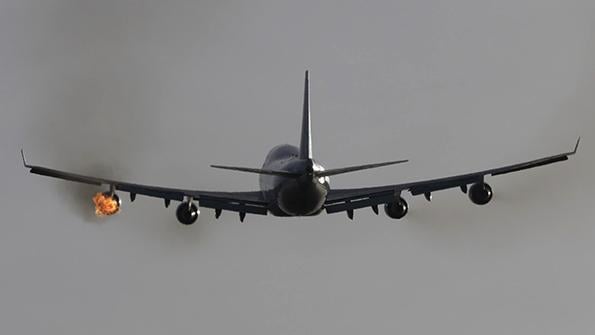
A Longtail Boeing 747-400’s contained No. 1 engine failure was caused by engine material deterioration.
The fallout from an engine failure aboard a Longtail Aviation Boeing 747-400 freighter underscores the importance of tracking service bulletin implementations and adds credence to some safety experts’ belief that regulators do not adequately account for risks from falling debris.
In the February 2021 incident, the Pratt & Whitney PW4056-powered 747-400F was on a scheduled flight from Maastricht Aachen Airport in the Netherlands to New York’s John F. Kennedy International Airport, the Dutch safety board’s final report says. Shortly after departing Runway 21 and passing through about 800 ft. above ground level, the No. 1 engine surged. Air traffic control radioed that flames were visible from the aircraft’s left side. The crew shut down the No. 1 engine and decided to make an emergency landing at nearby Liege Airport in Belgium, which has a longer runway than Maastricht. The aircraft landed without incident.
Investigators determined the contained engine failure was caused by deterioration of the high-pressure turbine (HPT) and its second-stage outer seal, which exposed outer transition ducts and their ceramic coatings to high temperatures. Over time, the ducts—which form a gas path between an engine’s low- and high-pressure turbines—deformed, causing a duct panel to break away. The panel was sucked into the engine, damaging turbine blades and sending fragments out in the exhaust.
The debris fell onto the village of Meerseen, which sits just beyond Maastricht-Aachen’s Runway 21, causing damage to cars and houses and injuring two people on the ground. One was hit by a fragment and hospitalized. The other suffered minor burns after picking up a piece of debris that was still hot.
More than 100 pieces of debris were collected—most of it fifth- and sixth-stage turbine blades and vanes, investigators said. The largest piece measured 23 X 4 cm (9 X 1.5 in.).
The probe determined the engine had not undergone work outlined in a March 1993 Pratt service bulletin meant to help prevent the problem.
“This modification improves the durability of the ceramic coating of the second- stage HPT duct segments by providing additional air required to cool these segments,” the report said. A subsequent service bulletin issued in October 1993 recommending installation of redesigned outer transition-duct segments was incorporated.
While it is possible for the failure scenario to occur even on engines with both modifications, Pratt’s analysis determined the Longtail failure would not have happened if the cooling modifications had been implemented, the Dutch safety board said.
Pratt said it has no record of a similar failure on an engine with both modifications. Based on findings from the Longtail probe, the manufacturer has used operators’ conferences to emphasize the importance of incorporating the added cooling features, the safety board said.
Longtail had put the newly leased 747-400F into service just three months before the incident. It did not have a record of why the service bulletin fix was not implemented—a document that should have been created and passed along as the aircraft changed operators.
“Having adequate record-keeping of maintenance documentation enables the operator and its maintenance organization to make sound risk management decisions about the continuing airworthiness of their [aircraft],” the board wrote. “This is crucial for the safe operation throughout the operating life of, in this case, the engine.”
The board recommended Longtail review and, if necessary, update its service bulletin records.
A 2012 FAA airworthiness directive based on an updated Pratt service bulletin mandated outer transition-duct upgrades. The FAA did not mandate the March 1993 cooling-expansion bulletin because it did not consider the ceramic deterioration issue a safety risk. The Dutch safety board recommended the FAA revisit its decision.
Investigators learned that while assessments are conducted to determine risks to areas around airports in the event of an accident, no similar practice exists for falling engine debris. Regulators, including the European Union Aviation Safety Agency (EASA), have determined that the probability of aircraft debris injuring people on the ground does not constitute a safety risk.
But Dutch investigators pointed to the Longtail occurrence and a 2019 incident involving a Norwegian Air Shuttle Boeing 787-8 as evidence of notable risk. The Norwegian 787 experienced an engine failure on departure from Rome Fiumicino International Airport. Debris, mostly turbine blade fragments, damaged several buildings and cars in Fiumicino.
Italian ANSV safety board investigators urged EASA to reexamine its stance, outlined in a 2018 certification memorandum, and the Dutch safety board concurred.
“[An] indicating of the risk of departing engine debris for people on the ground is provided in Certification Memorandum CM–21.A-A-001. This memorandum contains nonbinding information and does not constitute certification requirements or any legal obligation,” the Dutch safety board said. “It can be seen as a starting point to further develop the risk assessment of departing engine debris for people on the ground into regulations. This necessity to revise the assessment is underscored by the Italian ANSV investigation report concerning the incident that occurred over the city of Fiumicino in 2019.”





